MSI Megabook S271: a Look at AMD's Turion X2
by Jarred Walton on October 16, 2006 12:05 AM EST- Posted in
- Laptops
Multimedia and 3D Rendering
We mentioned earlier that there are specific reasons to consider getting a dual core system, with multimedia and 3D rendering applications often showing the most benefit. We ran some video and audio encoding benchmarks on the laptops in order to demonstrate multimedia performance. For 3D rendering, we use Cinebench 9.5 in both single-CPU and multi-CPU modes. We don't have single core performance available for the multimedia benchmarks in this article, although you can get an idea of the performance advantage from previous articles on the subject.
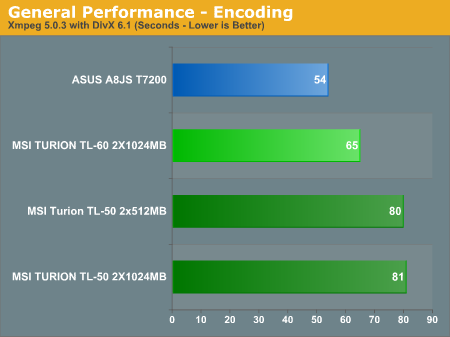
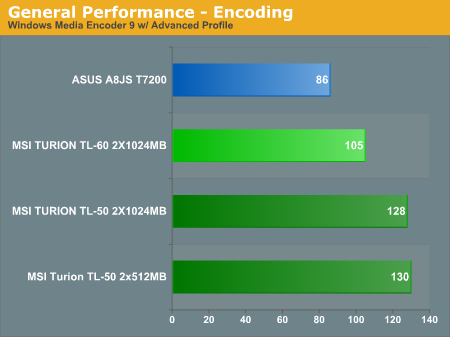
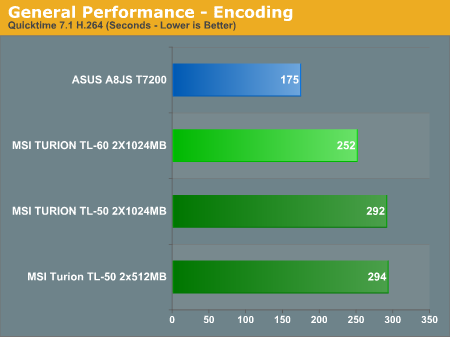
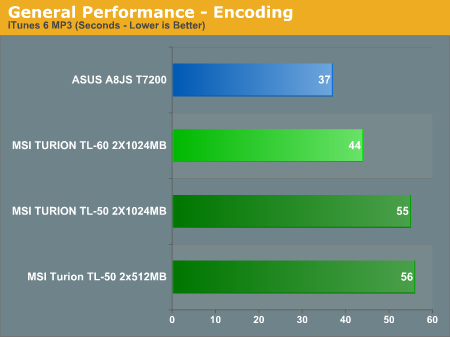
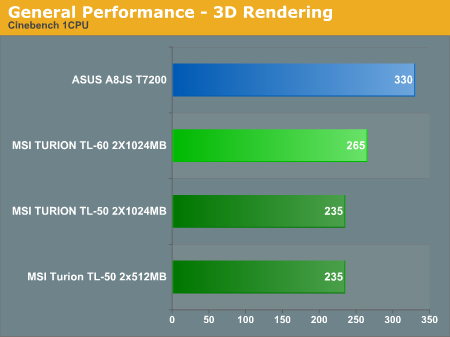

In the multimedia benchmarks, the ASUS Core 2 Duo outperforms the MSI Turion X2 by around 20% in three of the tests, while in the QuickTime H.264 encoding test the performance difference grows to 44%. For single core 3D rendering, the ASUS A8JS once again leads by slightly more than 20%, although it's interesting to note that in the multi-CPU rendering benchmark the performance lead drops to only 13%. Given how long 3D rendering can take, however, even moderate performance improvements can be very important. Of course, you can also purchase a faster Core 2 Duo notebook processor right now, whereas the TL-60 is the fastest Turion X2 currently available. If you need a high-performance dual core processor for a laptop, and you're willing to pay for it, you would probably want a CPU faster than what we have installed in either of the tested notebooks.
We mentioned earlier that there are specific reasons to consider getting a dual core system, with multimedia and 3D rendering applications often showing the most benefit. We ran some video and audio encoding benchmarks on the laptops in order to demonstrate multimedia performance. For 3D rendering, we use Cinebench 9.5 in both single-CPU and multi-CPU modes. We don't have single core performance available for the multimedia benchmarks in this article, although you can get an idea of the performance advantage from previous articles on the subject.






In the multimedia benchmarks, the ASUS Core 2 Duo outperforms the MSI Turion X2 by around 20% in three of the tests, while in the QuickTime H.264 encoding test the performance difference grows to 44%. For single core 3D rendering, the ASUS A8JS once again leads by slightly more than 20%, although it's interesting to note that in the multi-CPU rendering benchmark the performance lead drops to only 13%. Given how long 3D rendering can take, however, even moderate performance improvements can be very important. Of course, you can also purchase a faster Core 2 Duo notebook processor right now, whereas the TL-60 is the fastest Turion X2 currently available. If you need a high-performance dual core processor for a laptop, and you're willing to pay for it, you would probably want a CPU faster than what we have installed in either of the tested notebooks.










31 Comments
View All Comments
JarredWalton - Monday, October 16, 2006 - link
First, the "closed system" as such is not something we would recommend. Dual core with only 512MB of RAM? I already covered that. Second, the system *is* available as a barebones (MSI MS-1058), as I mentioned in the review. Memory compatibility aside, this isn't a great laptop. It's okay.The memory issues are something worth mentioning, even if we got them worked out. Even if everything had worked without issue, the laptop would have still only been okay - there are quite a few competing notebooks in the same price range, and this one fails to stand out from the crowd in any meaningful way.
Furen - Monday, October 16, 2006 - link
Sounds like you had huge memory compatibility problems, though. Personally, I always buy Crucial because when I used to buy other RAM (Kingston, etc), more often than not, I had some sort of memory compatibility problems (probably because I mixed brands but I've never had ANY problems at all with Crucial stuff).DrMrLordX - Monday, October 16, 2006 - link
I know the Core Duo is now an old product that is being replaced by the Core 2 Duo in the mobile sector, but it would have been nice to see the Turion X2 benchmarked against a Core Duo laptop as well. Surely a similarly-configured Core Duo machine exists out there somewhere.IntelUser2000 - Monday, October 16, 2006 - link
One thing is the Core 2 Duo laptop has 7200RPM HDD while the Turion X2 has 5400RPM. It shouldn't impact is greatly but it'll make a difference.IntelUser2000 - Monday, October 16, 2006 - link
Uhh. No. Clearly no. Explanation?? Turion X2 system uses integrated graphics, while Core 2 Duo system uses a powerful video card. Do you guys really think idle power of video card+chipset is equal to chipset alone??
IntelUser2000 - Monday, October 16, 2006 - link
http://www.computerbase.de/artikel/hardware/grafik...">http://www.computerbase.de/artikel/hard...hnitt_le...Integrated graphics power is clearly lower than even super low-end discrete. Now on this AT review we are talking about a mid-range part.
Sorry for triple post, but I must get my point across.
Two laptops, each possessed by one of my friends, both a Dell:
Pentium M 765 2.0GHz/533MHz FSB
1GB DDR2-533
120GB 5400RPM HDD
Geforce Go 7800GTX 128MB
15.4 inch wide-screen
70WHr battery
2.5 hour battery life with internet surfing, usage
2. Pentium M 1.6GHz/400MHz FSB/Dothan
512MB DDR2-533
Intel GMA900
60GB 4200RPM HDD
14 inch screen
45WHr battery
3.5 hour battery life with internet surfing, light usage
Is there a reason some high-end laptops are featured with integrated/discrete graphics card option?? You can turn one off?? Cause video cards in laptops suck huge amounts of power.
JarredWalton - Monday, October 16, 2006 - link
There are multiple issues involved with testing comparable laptops. Short of going out and purchasing a laptop, it's very difficult to pull off. At this point, there's not much reason to get a Core Duo notebook instead of a Core 2 Duo notebook, other than price. So we're doing our best to compare laptops that are similar, and we wanted to get this review out the door before it got any older. Obviously, we're still not recommending the MSI S271 over other laptops.In regards to Inteluser2000, he makes several comments. I have now reworded the page on power consumption to clarify a few points. However, not all of his points are entirely valid either. For example:
I don't think he was reading clearly, because I had just explained that at maximum CPU load MSI Turion X2 is consuming MORE power than ASUS Core 2 Duo. In other words, even with integrated graphics versus discrete graphics and with all of the other variables involved (7200 RPM hard drive versus 5400 RPM Drive, 14 inch LCD versus 12.1 inch LCD, etc.), without putting a load on the GPU one would expect the ASUS system to draw more power than the MSI system, and it doesn't. At idle, all of the variables can explain why the ASUS consumes more power, but when I put 100% load on just the CPU Turion X2 clearly requires more power.
I have no idea what he is trying to say with his comment about Dell laptops. Comparing a high-end system with a GeForce Go 7800 GTX to one that uses IGP is far worse than comparing something that uses GeForce Go 7700 to IGP. Different battery sizes, different display sizes, different processors, different hard drives, memory, etc. -- of course they're going to have different results. However, in this case are not drawing any final conclusions about idle power, other than to point out some interesting trends. What I am concluding is that if we were able to isolate just the CPU power use, a Turion X2 TL-60 at 100% load would require a lot more power than a Core 2 Duo T7200 at 100% load.
The ASUS system is there more as a frame of reference, particularly on the power requirements page. I really can't say for certain whether Turion X2 uses more power or less power at idle, but I am positive that it requires more power when it's placed under 100% load. Hope that explains things.
IntelUser2000 - Monday, October 16, 2006 - link
Nonono. I don't care about the load power, I care about your conclusions regarding idle. Even if you don't put load on the GPU, it consumes power. In laptop standards, lots of power. Its not a coincidence some laptop manufacturers put dual video card solutions(integrated/discrete), because they realize discrete cards affect battery life in idle, not just load. What I don't like is the explanation that its the CPU and chipset that contributes to idle power consumption and less battery life at DVD playback, Mobilemark, etc.
Check this out: http://www.trustedreviews.com/article.aspx?page=50...">http://www.trustedreviews.com/article.aspx?page=50...
(Dual GPU machine)
DVD playback
IGP: 164 minutes
Nvidia Geforce Go 6600: 112 minutes
MobileMark 2005 general battery life test
IGP:128 minutes
Geforce Go 6600: 92 minutes
30-40% battery life difference. Looks like video card is quite a big drain on battery life. I bet significant battery life difference between my friend's two system lies in the video card.
This is really a laptop review rather than a CPU review. Of course, due to laptops peculiarity of outperforming one with what looks like similar specifications, the idea of a CPU comparison on a laptop is far-fetched.
JarredWalton - Monday, October 16, 2006 - link
I did reword the rest of the page in regards to power use. I have used an ASUS W5F and found that it used about the same amount of power as the S271 (at idle). It was slightly more, so the remaining conclusions (i.e. Turion X2 in low power mode uses a bit less power) seem to be consistent. Tough to say 100% without nearly identical laptops - and you still have chipset and mobo components that can have an impact.IntelUser2000 - Monday, October 16, 2006 - link
You can find otherwise similar looking laptops that have different power consumption. How did you test out the W5F?? Just dropped in a Core 2 Duo in replacement of Core Duo?
Otherwise nice test.